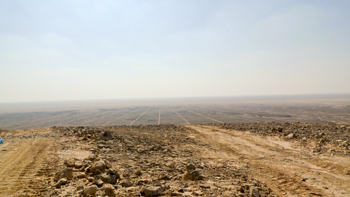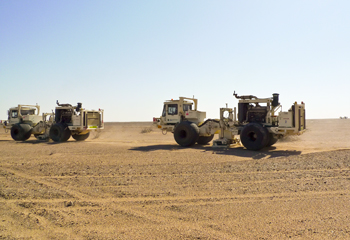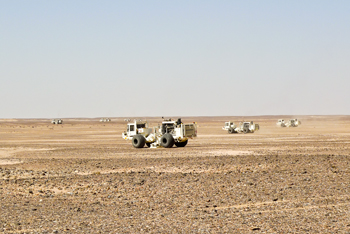Glenn Hauer, INOVA Geophysical
Improvements in Vibroseis operations through advancements in land acquisition technologies and techniques by equipment manufacturers offer substantial benefits to geophysical service operators and E&P companies. Increased surface sampling in a cost effective manner becomes more obtainable by using High Productivity Vibroseis (HPVS) techniques. These techniques used with high-channel count acquisition systems are ideal for the Middle East. E&P companies such as Petroleum Development of Oman (PDO) stand to gain the most from these techniques since they seek to lower their acquisition costs on a per-square-kilometer basis.
Petroleum Development Oman (PDO) is the major exploration and production company in the Sultanate. It accounts for more than 70% of the country's crude oil production and nearly all of its natural gas supply. PDO’s mission is to remain at the forefront of the Middle East region’s oil and gas business, both technologically and commercially. Accomplishing this objective often requires new ways of working with advanced technologies from equipment manufacturers. In turn, these equipment manufacturers are continuously collaborating with geophysical contractors in order to deliver the most efficient solutions. To fill this gap, INOVA Geophysical has developed a strong working relationship with the Bureau of Geophysical Prospecting (BGP International); this was seen as one of the primary advantages in the formation of the INOVA Joint Venture between BGP and ION. This relationship combines the innovation of INOVA product development and the extensive operational experience of BGP field personnel. The newly formed INOVA Geophysical is an independent provider of land geophysical equipment, which includes source technology, cabled and cableless land acquisition systems and digital sensors.
As one of the world’s largest service providers, BGP operates 115 land seismic crews in various parts of the world. BGP has acquired vast experience in performing large scale projects in the Middle East. BGP Oman Country Manager Meng Qingbing emphasizes the value in delivering increased operational efficiencies through High Productivity Vibroseis operations to E&P clients in order to fulfill their unique exploration objectives. “Having a choice in the selection of advanced geophysical equipment and techniques provides our business a competitive advantage.”
In the months of November and December 2010, a large scale field test was carried out in Oman by BGP International Oman Crew 8622B with the support of PDO, utilizing INOVA’s HPVS technology. This solution provided by INOVA consisted of the ARIES II seismic data acquisition system, Vib Pro source controllers, and AHV-IV 362 vibrators. The deserts of Oman provided optimal conditions to execute a successful test since HPVS operations are ideally carried out in vast, open spaces.
The ARIES II recording system was chosen for its capacity to perform large scale surveys with continuous recording and GPS synchronized real-time operational QC. For this particular test location, the AHV-IV series of vibrators from INOVA stood out for offering a variety of configurations that can operate in any terrain or environment. The vehicle’s patented Pre-Loaded Stilt Structure (PLS) design creates a stronger more reliable actuator able to deliver 60,000 lb (28t) peak force, making it ideal for High Productivity Vibroseis operations. The Vib Pro’s design allows seismic contractors to generate highly accurate sweeps, and have improved control of the fundamental ground force while fully managing operations of up to 32 simultaneous vibrator fleets.
During this field test, the ARIES II – Vib Pro recording-communication-shot control system was evaluated in respect to the efficiency of simultaneous Vibroseis recording techniques. These techniques, becoming ever more prevalent especially in the open desert environments of the Middle East and North Africa, are enabling oil and gas companies to cover vast areas with high quality data acquisition cost effectively, in effect a drive to reduce exploration costs per square kilometer down to the same levels as marine acquisition. Likewise, these techniques are enabling more efficient production in seasonally restricted areas such as Northern Canada, where the ability to acquire larger 3D surveys is compromised by short acquisition windows on frozen ground such as muskeg.
The following tests were planned with the support of PDO and BGP International:
1) Signal communication distance tests for the radio systems installed with ARIES and Vib Pro
2) Various slip-sweep recording scenarios such as short sweep – short slip and long sweep – short slip
3) Various vibrator fleet scenarios – single and multiple vehicles per fleet
4) Distance separated simultaneous sweep (DSSS) – two clusters with dynamic fleet grouping
5) Distance separated simultaneous sweep (DSSSM) – three clusters with dynamic fleet grouping.
6) Distance separated simultaneous slip-sweep (DSSSS) with dynamic fleet grouping
7) Independent simultaneous sweeping (ISS)
8) General communication protocols and fleet logistics protocols for cycle time efficiency and management
9) Vibrator Signature recording
10) General fleet positioning protocols with various implementations of GPS technology
During the tests, six oil companies sent their representatives to the crew to visit the ARIES II field operation, including PDO. In general, visitors were pleased with the promising productivity demonstrated during the tests, given that this was the first larger scale test conducted in the region with this equipment. The support of the exploration geophysics staff at PDO was of paramount importance in obtaining and use of a test site, as well as guidance in the selection of test parameters key to the success of operations in Oman. A total of 38,516 planned VPs of seismic data were acquired over a two week period.
“Our participation during the test allowed us to witness firsthand use of INOVA’s advanced technology while being operated by an experienced land seismic crew in order to achieve higher productivity levels in our region,” commented Said Mahrooqi, Head of PDO Geophysical Operations.
Test equipment availability was not ideal; only nine vibrators were available for testing, so in many cases eight vehicles were used in the simultaneous operations with one spare. Four fleets of two in slip-sweep mode, nine fleets of one in slip-sweep mode, two clusters of four in DSSS, and three clusters of three in DSSS: these were some of the configurations actually used in the operation.
Testing summary
Communications hardware and messaging protocols play a critical role in a large scale HPVS operation, especially in a distance separated technique. Distance tests were conducted as part of the distance separated two-and three-cluster tests, in which the distance between the vibrators and the recording instrument were extended from 12 km to 17 km. Communications were stable up to a distance of 16 km on a single radio frequency, including vibrator PSS message return to the central recording unit. At a distance of 17 km, PSS return was not stable, even though vibrators received their start messages. In addition, the seismic data was monitored to see the effectiveness of the source at such large distances. With a drive to record longer and longer offsets for use in full-wave form inversion, it is imperative that energy can be first generated and then subsequently recorded at distances of up 20-25 km. Furthermore, with the drive to acquire data with separation distances of up to 25 km so that there is no seismic interference at deeper reflection targets as well as longer swaths, the use of radio repeaters is necessary for proper communications in centrally guided source operations.
A large variety of slip-sweep scenarios were tested in order to better understand the system-vehicle messaging and communication protocol efficiencies. For example long sweep times combined with short slip and listen times result in a larger number of overlapping sweeps, pushing the central recording units processing capabilities as well as driving for efficient fleet ready, start, and PSS signal handling logistics. Messaging protocols have been developed and are now being improved to avoid signal collisions on the radio system. INOVA and BGP International evaluated and implemented improvements in the following subsystems: fleet networking and vibrator navigation, GPS source positioning, Vibroseis signature recording, sweep and shot QC, and dynamic fleeting due to irregular move-up times. “We found the capabilities of INOVA’s ARIES II recording and Vib Pro shooting system to be well designed. The user friendly interface made it easier for us monitor processes such as dynamic spread management, noise levels, and the vibrator’s health status,” acknowledged Meng.
All of the tests planned: slip-sweep, DSSS, DSSSS, and ISS were performed in the short time period available, as Crew 8622B needed to demobilize and move on to a regularly planned seismic project. The data was recorded in SEG-D format, simultaneously uncorrelated and correlated. Both SEGD and SEGY format can be chosen as a customer decision for media output. In addition the ground force for every sweep was recorded and logged via flash disk drives connected to the Vib Pro decoders in each vibrator.
BGP International achieved acceptable recording rates of up to 260 VPs/ hour with four fleets of two vibrators, and up to 570 VPs per hour with nine fleets of one vibrator, all in slip-sweep mode. Dynamic fleeting was successful, with vibrators in both two- and three- cluster DSSS operations able to match up on the fly with other clusters when the vibrators were ready to sweep. Independent simultaneous sweeping with eight vibrators was tested and uncorrelated continuously recorded data along with GPS clock timing for every sweep were acquired. Vibrators were able to start sweeps independently of the acquisition system.
Conclusions from the field test
The collaboration between PDO, BGP International and INOVA resulted in a successful demonstration of the ARIES II, Vib Pro, and AHV-IV vibrators working in a high productivity environment. Many of the recommended field implementations for HPVS recording have already been completed, with others in development and testing. INOVA is now ready to support larger scale continuous recording operations with a variety of simultaneous recording schemes. Powerful central computing platforms with ARIES II fiber optic cross-line cables/units supporting 16,000 channels real-time data transfer rate with up to four cross-lines, along with real-time operational QC, enable data acquisition contractors to conduct operations in demanding desert production environments. Central computing platforms on ARIES II can now handle four full fiber-optic cross-lines of 16,000 channels each, with 64,000 channel super-spreads operating in continuous mode (inclusive of auxiliary channels). Compute intensive operations, such as the output of correlated real-time multiple over-lapping shot records from slip-sweep techniques such as V1, are now being achieved. INOVA continues to develop computing hardware, where the bottle-necks in achieving high-channel counts are primarily in media handling, especially on output. Cooperation with INOVA’s other partner, ION Geophysical’s GXT Processing division, is enabling development engineers to access the latest in data handling techniques and technologies.
The addition of these capabilities will also enable contractors operating in other environments to increase their daily shooting production, as it has been demonstrated that slip-sweep, HFVS, and independent simultaneous sweeping operations are also effective in more highly cultured areas as well.
“Vibroseis techniques, such as those performed for this field test, allow for faster completion times when compared to conventional source acquisition methods. We believe our collaboration on this project with INOVA helped to narrow the gap between productivity and image quality that was required for us. As an E&P provider, it is to our benefit that service providers have access to equipment options that support techniques such as HPVS, thereby facilitating our need to operate more efficiently and with increased productivity for all of our seismic survey initiatives,” stated Mahrooqi.



|
Glenn Hauer – Senior Vice President, Product Management
Based in Houston, Glenn is INOVA’s Senior Vice President, Product Management. He is responsible for the development of all products in the INOVA portfolio, including acquisition systems, source technology, and sensors. Before being appointed to this position, Glenn served as Vice President, Marketing for ION Geophysical’s Next Generation Land Solutions business unit. Prior to ION’s acquisition of ARAM Systems in 2008, Glenn was Technical Marketing Director for ARAM Systems Ltd., a leading provider of cable-based land acquisition systems. Glenn had worked with ARAM in a variety of roles since 1997. Previously, Glenn worked in data processing with Geo-X Systems. Mr. Hauer holds a Bachelor of Science and a Master of Science in Engineering from the University of Waterloo.
|
|
| |
| |
|





